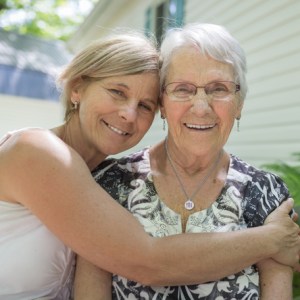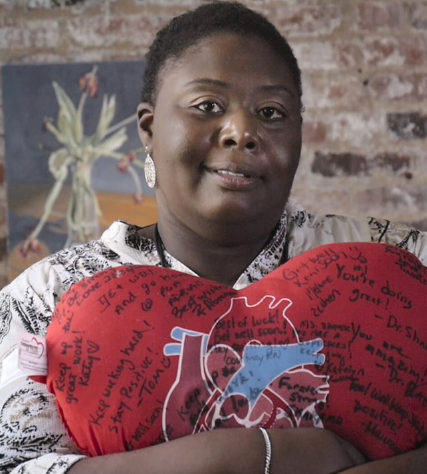
If they call MedicAlert, they know what to do,” Chrissy says. “And that means I can live my life without so much worry.
Chrissy, MedicAlert Member since 2018
Click Here to Renew. Need help? Call us at 1-800-432-5378 Monday – Friday 6:00 a.m. – 4:30 p.m. PT
Like many social workers, Chrissy, a MedicAlert member since 2018, has a big heart full of compassion for people in need. Over the years, she has given her time and energy to help victims of rape and domestic abuse in New York.
Chrissy used to be the Director of Social Service for a center that received as many as 900 patients every year. She is also busy with raising two teenage sons. Her goal in life is to help people and make a difference in the world.
While her heart for serving others remains strong, her physical heart cannot keep up. First diagnosed with congestive heart failure (CHF) in 2011, Chrissy is now waiting for a heart transplant.

Learn more about this condition on the medical conditions page.
Read More >
Read about other conditions that our MedicAlert members live with.
Read More >
Her health journey affects not just her life, but the lives of her two teenage sons. They are both helpful and attentive to their mom’s medical needs, but Chrissy’s diagnosis creates a lot of anxiety in the household. One of her sons admits that sometimes he still has nightmares about his mom’s condition. Chrissy is determined to not let her medical needs take away from their childhood and teenage years.
“I try to be as independent as I can,” she says. At the same time, she explains, “I don’t want any surprises.” She continues to keep her sons in the know about her condition and encourages them to talk to her doctors.
Because her heart condition is related to genetics, she wants to make sure her children stay as healthy and informed as possible.
Her condition may be dangerous, and it may be a long wait until she receives her heart transplant, but Chrissy is still optimistic and ambitious. Living in Queens, New York, she is in her last year of studying for her Masters Degree in International Crime and Justice. She originally wanted to move to her mother’s native Trinidad and Tobago to work with childhood sexual-abuse cases. Although she is waiting for her new heart, she hasn’t given up on this goal.
“When I get my heart—and I’m hopeful, I follow my coordinator’s directions—I’m going to be all over!” she laughs.
If they call MedicAlert, they know what to do,” Chrissy says. “And that means I can live my life without so much worry.
Chrissy, MedicAlert Member since 2018
Chrissy is determined to stay as independent and active as possible while waiting for her heart transplant. When she’s out and about, it is especially important for Chrissy to have a safety net.
For her, wearing a MedicAlert bracelet is more than just a precaution. In an emergency, it could mean the difference between life and death.
“People can’t even tell I have this machine,” she says about her LVAD. “Let’s say I pass out, from medication or dehydration, or let’s say the battery dies. You can’t do CPR because you could break the LVAD. These are things that people need to know.”
After receiving her LVAD, Chrissy started to research how she could let people know about her particular medical needs in case she is ever unconscious.
One of her cousins is a police officer, and they explained to her that first responders are trained to look for MedicAlert medical IDs.
Because of the LVAD, Chrissy does not have a natural pulse. In an emergency, it would be easy to mistakenly think she was dead. She also cannot receive treatment with an automated external defibrillator (a device that shocks the heart) because of her LVAD.
“If they call MedicAlert, they know what to do,” Chrissy says. “And that means I can live my life without so much worry.”
Source: American Heart Association
When a person’s heart is weakened and can’t pump blood as well as it should, this is called congestive heart failure. The heart is made up of muscle. Damage to this muscle or problems with its structure can lead to the heart becoming enlarged and weakened even more. It can be a life-threatening condition, and the only cure is a heart transplant.
There are many health concerns that can lead to congestive heart failure. This can include heart disease like coronary artery disease, infections, autoimmune problems, some chemotherapy drugs, and hereditary causes (genetics).
Chrissy’s CHF is mainly due to genetics, although a 2011 pregnancy made the condition worse. Things took a devastating turn when her baby died in labor. Her CHF stayed stable until 2017, when she started to feel crippling stomach pains. Her gastroenterologist ordered an endoscopy. Ulcers were found on the test, but the gastroenterologist was not convinced that was the only problem.
In February 2018, Chrissy had a stroke that landed her in the hospital. Then, she was hospitalized again for shortness of breath a month later. Doctors found that she was in Class IV heart failure, also known as end-stage heart failure. In April, she received a left ventricular assist device (LVAD) to support her heart’s ability to pump blood.
An LVAD is a device that is surgically implanted to help a weak heart pump blood. Part of the device is attached to a chamber of the heart called the left ventricle. This chamber is where the heart pumps blood into the body. Another part of the pump is attached to a controller outside the body, which means that Chrissy must carry this device with her everywhere she goes, recharging it at night.
While this sounds like an inconvenience, it has improved her quality of life. Before the implant, her diagnosis meant she was out of breath frequently and had difficulty speaking because her heart struggled to get oxygen to her body. Now, she speaks normally and has more energy.
LVADs are not a cure for congestive heart failure. But they do help people with the condition live longer. Some people use an LVAD for the rest of their lives, but for Chrissy, it’s a “bridge to transplant” while she waits to receive a new heart. Donor hearts are already difficult to come by, and because she is 6’1”, Chrissy needs a heart from a taller person.
Like other people who use LVADs to support their heart, Chrissy must watch for complications like infection at the site of implantation, blood clots, and possible device malfunctions. She also must be sure her family, friends, and any medical providers are aware of the device and what to do in an emergency.